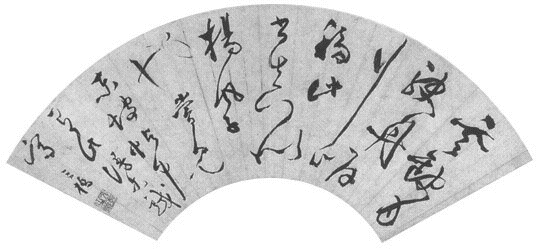
ˇ@
ˇ@
Chinese Calligraphy
ˇ@

Chinese calligraphy (Brush calligraphy) is an art unique to Asian cultures. Shu
(calligraphy), Hua (painting), Qin (a string musical instrument), and Qi (a
strategic boardgame) are the four basic skills and disciplines of the Chinese
literati.
Regarded as the most abstract and sublime form of art in Chinese culture, "Shu
Fa" (calligraphy) is often thought to be most revealing of one's personality.
During the imperial era, calligraphy was used as an important criterion for
selection of executives to the Imperial court. Unlike other visual art
techniques, all calligraphy strokes are permanent and incorrigible, demanding
careful planning and confident execution. Such are the skills required for an
administrator / executive. While one has to conform to the defined structure of
words, the expression can be extremely creative. To exercise humanistic
imagination and touch under the faceless laws and regulations is also a virtue
well appreciated.
By controlling the concentration of ink, the thickness and adsorptivity of the
paper, and the flexibility of the brush, the artist is free to produce an
infinite variety of styles and forms. In contrast to western calligraphy,
diffusing ink blots and dry brush strokes are viewed as a natural impromptu
expression rather than a fault. While western calligraphy often pursue font-like
uniformity, homogeneity of characters in one size is only a craft. To the
artist, calligraphy is a mental exercise that coordinates the mind and the body
to choose the best styling in expressing the content of the passage. It is a
most relaxing yet highly disciplined exercise indeed for one's physical and
spiritual well being. Historically, many calligraphy artists were well-known for
their longevity.
Brush calligraphy is not only loved and practiced by Chinese. Koreans and
Japanese equally adore calligraphy as an important treasure of their heritage.
Many Japanese schools still have the tradition of having a student contest of
writing big characters during beginning of a new school year. A biannual
gathering commemorating the Lanting Xu by Wang Xi Zhi (The most famous Chinese
calligrapher in Jin dynasty, ) is said to be held ceremonially in Japan. There
is a national award of Wang Xi Zhi prize for the best calligraphy artist. Not
too long ago, Korean government officials were required to excel in calligraphy.
The office of Okinawa governor still displays a large screen of Chinese
calligraphy as a dominating decor.
In the West, Picasso and Matisse are two artists who openly declared the
influence by Chinese calligraphy on their works.
Click Chinese Calligraphy's related products
Back to Home
|
Peony is called the queen of the flowers in China, its beatific indication makes peony one of the most popularly used patterns in China. With peony brocade patterns inside out, this pair of shoes is designed in low rim and you can regard it as shoes or slippers as your wish. |
|
Original Style: As shown in photo chinese dresses
Painted with matched tulips, this pair of slippers looks extremely elegant. Its stylish design makes it perfect. Rest at home, it will be your best choice. chinese kites and fans Pattern 1: Carved with the Tibetan Six-Syllable Mantra Om Ma Ni Pad Me Hung, which is a phrase awakens compassion and loving-kindness for welfare of all beings. chinese painting Pattern 2: Craved with the Eight Auspicious Symbols of Buddhism - a conch shell, a lotus, a wheel, a parasol (umbrella), an endless knot, a pair of golden fishes, a banner proclaiming victory, and a treasure vase. kung fu shoes Pattern: Dancing dragon printed in the front kung fu uniform asian apparel Pattern: Dragon Embroidery along the Front Piping kung fu uniform asian dress Pattern: Embroidered with Fu and Xi patterns in dancing dragon shape in the front kung fu uniform asian wedding dress Make a bold fashion statement in a pair of these plain pants come with double-layer style. Orange or green cotton inside and black voile outer layer with slits, these pants are sure to attract many comments from admirers. chinese clothing oriental silk fabrics Make this handkerchief yours! It is hand painted with bamboo tree. Vivid painting increases its charm. Add it to your Chinese collections, it makes you more elegant. chinese clothing oriental style shoes Make this handkerchief yours! It is hand painted with ripe grapes. Vivid painting increases its charms. Add it to your Chinese collections, it makes you more elegant. chinese clothing oriental wedding dress Matching pants are designed with both elastic band and cotton band. chinese clothing women dress Mysteriously, this bracelet is made in a wolf teeth shape! It's vivid and actual. As in the belief of Tibetans, wolf teeth symbolize men's braveness and strength. Three wolf teeth bunched together, means fortune and security. The bracelet is not only a decoration, but also an amulet and will bring you lucky and happiness for ever. chinese clothing women suit Ordinary silo shape design makes the handbag looking clumsy but not this one. You can adjust the rope to enlarge the capacity, you can also tie a bowknot to increase its loveliness. There is batik cotton shirt sewn underneath with four pockets helping you to hold things for frequent use. chinese dress |